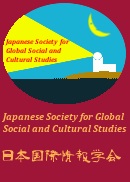Volume 11, Issue 1
The Journal of Japanese Society for Global Social and Cultural Studies 11_1
Displaying 1-5 of 5 articles from this issue
- |<
- <
- 1
- >
- >|
Original2014
-
2014Volume 11Issue 1 Pages 3-19
Published: December 19, 2014
Released on J-STAGE: December 19, 2014
Download PDF (937K) -
2014Volume 11Issue 1 Pages 20-31
Published: December 19, 2014
Released on J-STAGE: December 19, 2014
Download PDF (1484K) -
2014Volume 11Issue 1 Pages 32-43
Published: December 19, 2014
Released on J-STAGE: December 19, 2014
Download PDF (839K) -
2014Volume 11Issue 1 Pages 44-55
Published: December 19, 2014
Released on J-STAGE: December 19, 2014
Download PDF (834K) -
2014Volume 11Issue 1 Pages 56-67
Published: December 19, 2014
Released on J-STAGE: December 19, 2014
Download PDF (802K)
- |<
- <
- 1
- >
- >|
